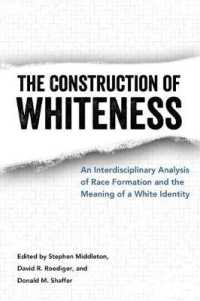Full Description
This work marks the beginning of a new Dalit self-understanding and a new appreciation for the changed landscape of the twenty-first century where the agency of Dalits in the area of theology has exploded the monopoly of caste interpretations in a significant manner. This volume addresses how despite its proud entry into the post-colonial, politically democratic twenty-first century world, India continues to straddle the structural inequalities and functional hierarchies based on its age-old caste system. It also looks at various Dalit, women, tribal, and other subaltern movements that struggle against insidious forms of caste-, class-, ethnicity- and religion-based violence and violation. A unique combination of Dalit theology with Dalit feminism and feminist theology, this book brings together the key directions and interests that Dalit Theology has taken in the new century.
Contents
INTRODUCTION; ; SECTION I: DALIT THEOLOGY: INTRODUCTION, INTERROGATION AND IMAGINATION ; 1. The Heroine's Song in the Marathi Theatre between 1910 and 1920: its Code and its Public (Sathianathan Clarke); ; 2. Expanding the Ambit: Dalit Theological Contribution to Ecumenical Social Thought (M. Deenabandhu); ; 3. The Diversity and Dialectics of Dalit Dissent and Implications for a Dalit Theology of Liberation (Peniel Jesudason Rufus Rajkumar); ; 4. In the Beginning is also an End: Expounding and Exploring Theological Resourcefulness of Myths of Dalit Origins (Philip Vinod Peacock); ; 5. Envisioning a Postmodern Method of Doing Dalit Theology (Y.T. Vinayraj); ; 6. TRANS-formative Possibilities: Tribal Formations in Conversation with Dalit Theology (Lalruatkima); ; SECTION II: FORAGING DALIT WORLDS, FREEING THEOLOGICAL SYMBOLS, FORGING DALIT WORD VISIONS ; 7. Jesus and Ambedkar: Exploring Common Loci For Dalit Theology and Dalit Movements (Esther Chitra); ; 8. Gonthemma Korika: Re-imagining the Divine Feminine in Dalit Christian Theo/alogy (Joseph Prabhakar Dayam); ; 9. Exploring New Facets of Dalit Christology in Critical Interaction with J. D. Crossan's Portrayal of the Historical Jesus (Anderson Jeremiah); ; 10. Dalit Theology and its Future Course (Geevarghese Mar Coorilos); ; 11. Dalits and Religious Conversion: Slippery Identities and Shrewd Identifications (Sathianathan Clarke and Philip Vinod Peacock); ; SECTION II: DALIT HERMENEUTICS: NEW CHRISTIAN VEDAS, OLD GOSPEL, DIFFERENT VOICES ; 12. Turning the body inside out: Contours of Womanist Theology (Evangeline Anderson-Rajkumar); ; 13. Bama's Critical-constructive Narratives: Interweaving Resisting Visible Bodies and Emancipatory Audacious Voice as TEXTure for Dalit Women's freedom (Roja Singh); ; 14. The Servant in the Book of Judith: Interpreting her Silence, Telling her Story (Monica Jyotsna Melanchthon); ; 15. Visibility of Her Sins: Reading the "Sinful Woman" in the Gospel of Luke 7: 36-50 from a Dalit Feminist Perspective (Surekha Nelavala); ; 16. Caste Branding, Bleeding Body, Building Dalit Womanhood: Touchability of Jesus (Nelvala G. Prasuna).






